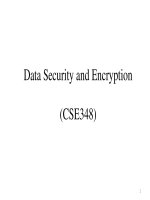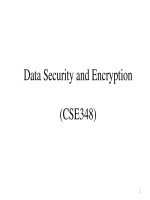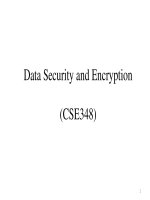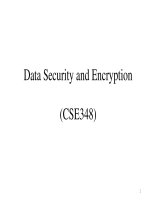Lecture Data security and encryption - Chapter 11: Basic concepts in number theory and finite fields
Bạn đang xem bản rút gọn của tài liệu. Xem và tải ngay bản đầy đủ của tài liệu tại đây (433.25 KB, 52 trang )
Data Security and Encryption
(CSE348)
1
Lecture # 11
2
Review
– The AES selection process
– The details of Rijndael – the AES cipher
– Looked at the steps in each round
– Out of four AES stages, last two are
discussed
• MixColumns
• AddRoundKey
– The key expansion
– Implementation aspects
3
Chapter 4
Basic Concepts in Number Theory
and Finite Fields
4
The next morning at daybreak, Star flew indoors, seemingly keen for
a lesson. I said, "Tap eight." She did a brilliant exhibition, first
tapping it in 4, 4, then giving me a hasty glance and doing it in 2, 2,
2, 2, before coming for her nut. It is astonishing that Star learned to
count up to 8 with no difficulty, and of her own accord discovered
that each number could be given with various different divisions, this
leaving no doubt that she was consciously thinking each number. In
fact, she did mental arithmetic, although unable, like humans, to
name the numbers. But she learned to recognize their spoken
names almost immediately and was able to remember the sounds of
the names. Star is unique as a wild bird, who of her own free will
pursued the science of numbers with keen interest and astonishing
intelligence.
— Living with Birds, Len Howard
5
Introduction
• Finite fields have become increasingly important
in cryptography
• A number of cryptographic algorithms rely
heavily on properties of finite fields
• Notably the Advanced Encryption Standard
(AES) and elliptic curve cryptography
6
Introduction
• The main purpose of this chapter is to provide
the reader with sufficient background on the
concepts
• of finite fields to be able to understand the
design of AES
• and other cryptographic algorithms that use
finite fields
• some basic concepts from number theory that
include divisibility, the Euclidian algorithm, and
modular arithmetic
7
Introduction
• will now introduce finite fields
• of increasing importance in cryptography
– AES, Elliptic Curve, IDEA, Public Key
• concern operations on “numbers”
– where what constitutes a “number” and the
type of operations varies considerably
• start with basic number theory concepts
8
Divisors
• say a non-zero number b divides a if for
some m have a=mb (a,b,m all integers)
• that is b divides into a with no remainder
• denote this b|a
• and say that b is a divisor of a
• eg. all of 1,2,3,4,6,8,12,24 divide9 24
• eg. 13 | 182; –5 | 30; 17 | 289; –3 | 33; 17 | 0
9
Properties of Divisibility
•
•
•
•
If a|1, then a = ±1.
If a|b and b|a, then a = ±b.
Any b /= 0 divides 0.
If a | b and b | c, then a | c
– e.g. 11 | 66 and 66 | 198 x 11 | 198
• If b|g and b|h, then b|(mg + nh)
for arbitrary integers m and n
e.g. b = 7; g = 14; h = 63; m = 3; n = 2
hence 7|14 and 7|63
10
Properties of Divisibility
• If b|g and b|h, then b|(mg + nh)
for arbitrary integers m and n
e.g. b = 7; g = 14; h = 63; m = 3; n = 2
hence 7|14 and 7|63
then b|(mg + nh)
7/(3*14+2*63)
11
Division Algorithm
• if divide a by n get integer quotient q and
integer remainder r such that:
– a = qn + r where 0 <= r < n; q = floor(a/n)
• remainder r often referred to as a residue
12
Division Algorithm
13
Division Algorithm
• Figure 4.1a demonstrates that, given a and
positive n
• It is always possible to find q and r that satisfy
the preceding relationship
• Represent the integers on the number line
• a will fall somewhere on that line
– positive a is shown, a similar demonstration can be
made for negative a
14
Division Algorithm
• Starting at 0, proceed to n, 2n, up to qn such
that qn <= a and (q + 1)n > a
• The distance from qn to a is r, and we have
found the unique values of q and r
For example:
a = 11; n = 7; 11 = 1 x 7 + 4;
a = –11; n = 7;
q = –2
r=4q=1
–11 = (–2) x 7 + 3;
r=3
• Figure 4.1b provides another example
15
Greatest Common Divisor (GCD)
• One of the basic techniques of number theory is
the Euclidean algorithm
• which is a simple procedure for determining the
greatest common divisor of two positive integers
• Use the notation gcd(a,b) to mean the greatest
common divisor of a and b
16
Greatest Common Divisor (GCD)
• Positive integer c is said to be the greatest
common divisor of a and b if c is a divisor of a
and of b
• and any divisor of a and b is a divisor of c
• We also define gcd(0, 0) = 0
• State that two integers a and b are relatively
prime if their only common positive integer factor
is 1, i.e. GCD(a,b)=1
17
Greatest Common Divisor (GCD)
a common problem in number theory
GCD (a,b) of a and b is the largest integer that
divides evenly into both a and b
eg GCD(60,24) = 12
define gcd(0, 0) = 0
often want no common factors (except 1)
define such numbers as relatively prime
eg GCD(8,15) = 1
hence 8 & 15 are relatively prime
18
Example GCD(1970,1066)
1970 = 1 x 1066 + 904
1066 = 1 x 904 + 162
904 = 5 x 162 + 94
162 = 1 x 94 + 68
94 = 1 x 68 + 26
68 = 2 x 26 + 16
26 = 1 x 16 + 10
16 = 1 x 10 + 6
10 = 1 x 6 + 4
6 = 1 x 4 + 2
4 = 2 x 2 + 0
gcd(1066, 904)
gcd(904, 162)
gcd(162, 94)
gcd(94, 68)
gcd(68, 26)
gcd(26, 16)
gcd(16, 10)
gcd(10, 6)
gcd(6, 4)
gcd(4, 2)
gcd(2, 0)
19
Example GCD(1970,1066)
• Illustrate how we can compute successive
instances of GCD(a,b) = GCD(b,a mod b).
• This MUST always terminate since will
eventually get a mod b = 0 (ie no remainder
left)
• Answer is then the last non-zero value. In this
case GCD(1970, 1066)=2
20
GCD(1160718174, 316258250)
Dividend
a = 1160718174
b = 316258250
r1 = 211943424
r2 = 104314826
r3 = 3313772
r4 = 1587894
r5 = 137984
r6 = 70070
r7 = 67914
r8 = 2516
Divisor
b = 316258250
r1 = 211943424
r2 = 104314826
r3 = 3313772
r4 = 1587894
r5 = 137984
r6 = 70070
r7 = 67914
r8 = 2516
r9 = 1078
Quotient
q1 = 3
q2 = 1
q3 = 2
q4 = 31
q5 = 2
q6 = 11
q7 = 1
q8 = 1
q9 = 31
q10 = 2
Remainder
r1 = 211943424
r2 = 104314826
r3 = 3313772
r4 = 1587894
r5 = 137984
r6 = 70070
r7 = 67914
r8 = 2516
r9 = 1078
r10 = 0
21
GCD(1160718174, 316258250)
• This example shows how to find d = gcd(a, b) =
gcd(1160718174, 316258250), shown in tabular
form
• In this example, we begin by dividing 1160718174
by 316258250, which gives 3 with a remainder of
211943424
• Next we take 316258250 and divide it by
211943424
22
• The process continues until we get a remainder of
Modular Arithmetic
• Given any positive integer n and any nonnegative integer a
• If we divide a by n, we get an integer quotient q
and an integer remainder r
• In modular arithmetic we are only interested in
the remainder (or residue) after division by some
modulus
23
Modular Arithmetic
• and results with the same remainder are
regarded as equivalent
• Two integers a and b are said to be congruent
modulo n, if (a mod n) = (b mod n)
24
Modular Arithmetic
• define modulo operator “a mod n” to be
remainder when a is divided by n
– where integer n is called the modulus
• b is called a residue of a mod n
– since with integers can always write: a = qn + b
– usually chose smallest positive remainder as residue
• ie. 0 <= b <= n-1
– process is known as modulo reduction
• eg. -12 mod 7 = -5 mod 7 = 2 mod 7 = 9 mod 7
• a & b are congruent if: a mod n = b mod n
– when divided by n, a & b have same remainder
– eg. 100 = 34 mod 11
25









